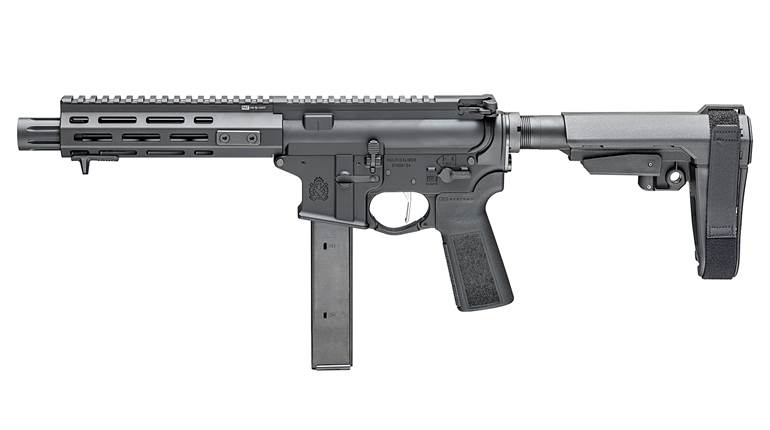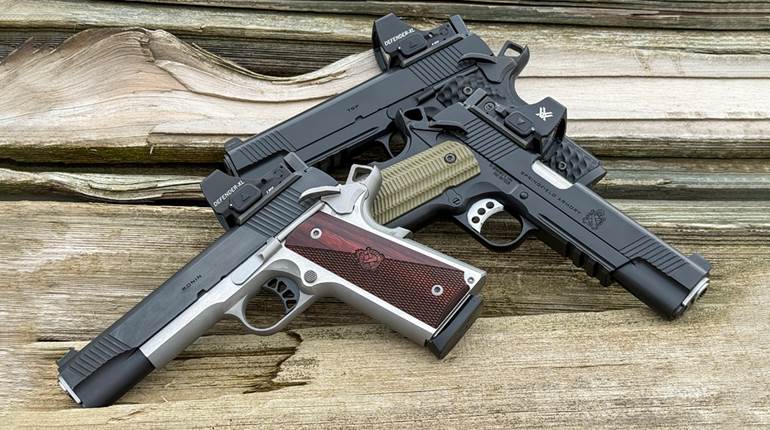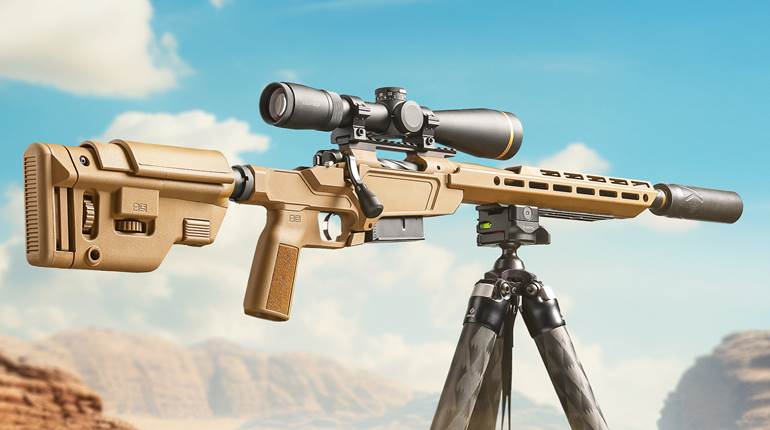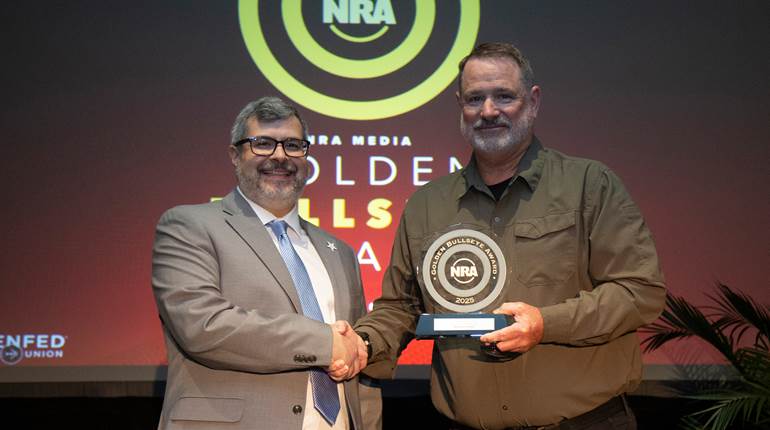
The decision to carry a handgun for personal protection imposes a dilemma in that the size and weight of the gun are likely to be inversely proportional to its capacity and power. That largely explains why pocket pistols chambered in .380 ACP surged in popularity several years ago. Because they were small and light, they were more likely to be carried habitually rather than left behind. But many who bought those guns would have preferred a more powerful chambering or additional rounds, which explains why firearm manufacturers have since somewhat reprised their earlier success with small, single-stacks chambered in 9 mm Luger.
It was amid that backdrop that Springfield Armory recently introduced the all-new XD-S, a subcompact, polymer-frame single-stack that measures 1"x4.4"x6.3" and weighs 21.5 ozs. Those numbers alone would not be particularly impressive were it not for the fact that the XD-S is chambered in one of America’s most respected defensive handgun cartridges: the .45 ACP. That places the newest XD nearly in a class by itself.
Bucking The Trend
The XD-S is made in Croatia by Springfield manufacturing partner HS Produkt, which is best known for developing that country’s service pistol, the HS2000. When Springfield secured U.S. licensing and marketing rights to the gun in 2002, it renamed it “XD-9,” for X-treme Duty 9 mm Luger, and began to introduce numerous chamberings, frame sizes and barrel lengths. The popularity of XD pistols within competition and personal-defense circles increased exponentially during the following decade, and in 2008 the XD(M) platform introduced additional match-oriented features and refinements, further bolstering the XD brand.
But even the smallest XD and XD(M) pistols were fed from staggered, double-column magazines, which left Springfield out of the burgeoning subcompact, concealed-carry market where the emphasis has been on thin carry guns that, by necessity, were fed from single-stack magazines. Of course, it already had one of the most extensive lines of M1911-based pistols on the market, including the 3"-barreled Micro Compact Lightweight in .45 ACP, its smallest gun in that chambering. But the XD-S is even shorter, by 0.4", yet has a 0.3" longer barrel and is 4.5 ozs. lighter. Even compared to the EMP, Springfield’s smallest M1911-based gun, available only in 9 mm Luger and .40 S&W, the XD-S is smaller and lighter. And compared to the next-smallest XD, the 3"-barreled Sub-Compact in 9 mm Luger, the XD-S is narrower by 3/16" in the slide and 5/16" in the grip frame and is 4.5 ozs. lighter.
Dave Williams, head of Springfield’s custom shop in Geneseo, Ill., and a nationally recognized M1911 pistolsmith, worked closely with HS Produkt engineers on the XD-S project. Recalling the gun’s primary design objectives, Williams said, “We tasked our friends in Croatia to build a small carry gun, and we wanted the thinnest pistol we could get. We knew it needed to be a single-stack, but we gave the engineers a broad brush to paint with in terms of the design. They came up with some concepts, and the first one was chambered in 9 mm Luger … but we knew we wanted something special, and we decided early on to do something really cool.”
That “something really cool,” of course, was found in the stout, slow-moving but hard-hitting .45 ACP cartridge. Indeed, because of its greater energy than many smaller-caliber cartridges and because of its tendency to create more devastating permanent wound cavities, the .45 ACP had a longstanding reputation as a first-rate self-defense cartridge. So if the idea of a subcompact, single-stack semi-automatic .45 ACP pistol was such a good one, why hadn’t it become more popular? Simply put, because the same characteristics that make the cartridge desirable ballistically make it problematic mechanically when designing a compact platform around it. Specifically, its overall diameter and length (0.480" and 1.275", respectively) dictate that any gun designed to handle it must have frame and magazine dimensions significantly larger than those of guns chambered for the 9 mm Luger (0.394" and 1.169") or .40 S&W (0.424" and 1.135"). In addition, the parts that move during the gun’s cycle of operation, primarily the barrel and slide, have to be of sufficient mass to offset the energy the cartridge produces. But that’s at odds with the fact that reducing the slide’s mass causes it to travel at a higher velocity, which requires that the gun go into and out of battery faster.
Engineering A Solution
While the .45 ACP will forever be linked, no pun intended, with the M1911, contemporary engineers generally seek simpler locking systems that post-date Browning’s masterpiece when designing modern guns around it. “The length and mass of the slide on an M1911-type pistol are designed to absorb the recoil impulse of that cartridge,” said Williams. “When you lighten the slide, you run into reliability issues, and we knew we had to make the pistol reliable. The reciprocating assembly of the XD-S is lighter than it should ideally be.” In fact, the complete XD-S barrel/slide assembly weighs only 13.1 ozs. compared to 18.1 ozs. for the same components of a full-size M1911.
To account for that difference, the XD-S was designed more along the lines of the later, and simpler Browning Hi-Power—with elements from even more recent designs added in. Specifically, it uses a wedge-shaped cross piece at the rear of its steel locking block, which is pinned to the polymer frame, to engage an angled cutout in the barrel’s underlug. That interface cams the barrel out of battery as it and the slide move rearward together a short distance under recoil. The cross piece then initiates the barrtel’s locking as it returns to battery, raising its hood to engage the front and rear of the slide’s ejection port. A slightly enlarged section of the barrel at its muzzle mates with an opening at the slide’s front to ensure precise lockup.
Minimal upward travel is required to relock the barrel into battery after the slide returns from picking up a fresh round from the magazine. Combined with relative simplicity of the locking system, as compared with that of the M1911, the pistol’s reliable operation is all but ensured. Williams summed it up by saying, “The chamber area of the barrel itself is one big locking lug, so it unlocks faster than a conventional M1911 pistol would.”
Further taming the .45’s recoil impulse is a self-contained recoil spring assembly consisting of two nested coil springs held captive by a steel guide rod and sleeve. The assembly’s front end fits into a mating hole at the front of the slide and the rear end rests in a notch in the barrel underlug’s face. The assembly is a self-contained unit, and no tools are required to remove or reinsert it, easing field stripping of the pistol.
Parts mounted in the frame of the XD-S feature robust construction with few stampings. The steel locking block also forms the front slide rails. Another steel block, pinned in the frame behind the magazine well, forms the rear slide rails, houses the sear and disconnector, and serves as a pivot point for the grip safety. A trigger bar that lies along the frame’s right side raises a striker pin safety as it travel rearward, clearing the striker’s channel in the slide so that the striker can travel forward after being released by the sear.
The slide is machined from bar stock steel and is treated with flat-black Melonite—a salt bath nitriding process that resists corrosion and hardens the metal’s surface. Its 7/8" width is equal to or narrower than that of the frame, but five grasping ridges at its rear provide excellent purchase because they are widely spaced and formed in such a way that they are much deeper on the corners. Facets at the slide’s front face ease reinsertion of the gun into a holster. On top, the front and rear sights are dovetailed in place, the former holding a red fiber-optic strand and the latter featuring a white dot on either side of a square notch in its serrated face. Both are shaped to minimize snagging on clothing and holsters.
A loaded-chamber indicator lies at the center rear of the ejection port. A case present against the breechface raises its front end, which can be felt easily even in the dark. On the slide’s right side, behind the ejection port, a pivoting extractor lies in a machined pocket and is tensioned by a coil spring at its rear.
Realizing The Result
The XD-S offers many subtle enhancements that, only a few years ago, were not found on many full-size pistols—let alone on compact models—and each is incorporated into the pistol’s functional controls in such a way as to result in an ergonomically and aesthetically appealing package.
The frame incorporates an accessory rail that accommodates white lights and lasers (See p. 40). The front of the trigger guard has a single row of block-style checkering for those who care to place the forefinger of the support hand in that location. An undercut at the trigger guard’s rear, where it meets the grip frame, provides maximum purchase by the firing hand’s middle finger to the six horizontal rows of block-style checkering that wrap around the front of the grip frame from each side. Round ambidextrous magazine release buttons protrude from semi-circular recesses in the frame, and their checkered surfaces angle toward the pistol’s front. The steel magazine catch pivots forward when the buttons are pressed inward from either side, withdrawing two projections at the top of the catch that engage mating holes in the front of the magazine. A bevel on the magazine well’s mouth aids insertion of the stainless steel magazines, which are highly polished and exhibit no seams or spot welds. Numbered witness holes in both of the included five-round magazines and in the optional seven-round version provide a visual confirmation of the number of rounds remaining. The seven-round magazine additionally features a polymer sleeve that extends the grip frame’s contours by 1", lending the XD-S the feel and handling qualities of a full-size service pistol.
The gun features a blade-in-bow trigger design in which the blade in the center bottom of the trigger’s face must first pivot in order to clear the frame, allowing the main bow to travel rearward. Combined with the grip safety, it greatly minimizes the possibility of an inadvertent discharge and helps ensure that a firm grasp on the pistol and a deliberate pull of the trigger are required to fire it. The trigger has approximately 1/4" of takeup before encountering noticeable resistance. Then another 1/4" of travel ends in a reasonable pull weight—6 lbs, 8 ozs. for theevaluation sample—that releases fairly crisply and with no overtravel. Reset occurs after the trigger travels forward approximately 3/16" with an audible and tactile “click.”
Each of the two provided backstrap inserts have five horizontal rows of block-style checkering and can be exchanged simply by drifting out a roll pin. The grip safety, which blocks the sear until depressed, is neatly blended in with the contours of the backstrap and activates with minimal pressure. The slide stop lies above a slight thumb rest in the grip frame and is fenced along its bottom, front and rear edges to preclude its being inadvertently engaged during firing.
The XD-S fieldstrips in the same manner as the original XD, but adds a blocking lever that moves into the magazine well when the disassembly lever is rotated upward, precluding insertion of a magazine. It conversely disallows the lever’s being raised into the disassembly position if a magazine is present in the gun.
Attaining A Goal
So how did Springfield Armory and HS Produkt engineers pull off the XD-S? One way was through strict quality control of components, which are nearly all manufactured under HS Produkt’s roof. Also, Williams said, “They optimized a lot of small things in order to get the pistol to run flawlessly—for instance, the angle, depth and position of the extractor claw were tuned. And the extractor was given a little more than usual tension.”
Finally, he said, “We did a lot of endurance and reliability testing on the gun and found that it is very reliable and that nothing on it is prone to breakage.” In addition, he noted that the XD-S is not ammunition-sensitive. “Any factory service ammunition will work in this gun, and it will stand up to a steady diet of +P loads,” he said. He warned, however, that inexperienced shooters who may not have a proper grip the gun could induce short stroking of the action by “limp wristing” it during firing. “But if you do grip it properly,” he assured, “it’s as reliable as anything.”
Several NRA staff members with differing levels of experience and ranging from petite women to burly men put those claims to the test by shooting the XD-S with a variety of factory ammunition. While it’s true that most said they were not looking forward to shooting such a small, light pistol chambered in .45 ACP, after drawing and firing the gun from the standing position and from the bench to get a feel for its shooting manners, none were overly put off by its recoil. In fact, one experienced tester commented that the gun was “unusually mild-mannered.” Another said, “It’s surprisingly good considering it’s a .45,” adding, “Once you get that third finger wrap with the extended magazine, it’s even easier to shoot well.” Finally, one said, “Considering the caliber, I was expecting it to be uncomfortable to shoot; but I found it to be light, comfortable to hold and easy to control.”
During range evaluation, more than 300 rounds were fired from the XD-S with no mechanical malfunctions, and accuracy testing was conducted according to American Rifleman protocol firing five five-shot groups using three factory loads at a realistic self-defense distance of 7 yds. Results are tabulated on p. 53 and illustrate that the XD-S has more than enough inherent accuracy to accomplish the task for which it was designed. In addition it was noted that the gun’s 3.3" barrel produces adequate velocities to ensure proper expansion with most defensive-type bullets.
There’s no question that the XD-S is special because of its chambering, but those who find its other attributes enough to recommend it will be pleased to know that Springfield already has plans to produce the pistol in “other popular calibers” in the future, according to Williams.
Until then, Springfield Armory has convincingly combined power and portability in a package that few who consider the XD-S objectively could fail to recognize for the engineering accomplishment it is: a carry gun that doesn’t have to be left behind in favor of something smaller or lighter—and certainly not in favor of something more powerful.





































